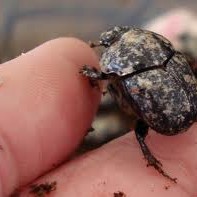 Good summer rainfall in many grazing regions means dung beetle populations are increasing, and beef producers should be looking at management techniques to enhance numbers, says grazing management consultant, Mick Alexander.
Good summer rainfall in many grazing regions means dung beetle populations are increasing, and beef producers should be looking at management techniques to enhance numbers, says grazing management consultant, Mick Alexander.
It has now been almost 50 years since CSIRO introduced the first colonies of dung beetles into Australia, and maps, accessible here, clearly show the diversity of populations of both native and introduced species across the Australian grazing landscape.
Population density maps produced as part of the Queensland Dung Beetle Project back in 2002 show the typical number of dung beetles producers should have in their area during summer conditions.
“If producers do not have this many or more species in their local area, there are some serious questions to be asked,” Mr Alexander said in a recent Grazing Best Prac extension advice alert to producers.
During the Queensland dung beetle project, more than 7300 introduced dung beetles and 6300 native species were collected from a single dung beetle trap.
“At the same time, other areas recorded only 10-20 or even fewer beetles collected,” Mr Alexander said.
“This variation is partly due to climate and geography, but also management factors. In the past two months, dung beetle populations have been slowly building in most districts.”
He said there could be a combination of reasons why some locations did not currently have good numbers of introduced dung beetles in paddocks:
- Drenches and dips in use (all dips and drenches had some impact on beetle populations)
- Conditions were too dry, or extremely wet
- Predators (crows, ibis, cane toads)
- Region-scale populations are low (reference maps below).
“The dung beetle is an essential tool in cycling nutrients from cattle, sheep and horses back into the soil,” Mr Alexander said.
“In a grazing system, it is an effective method of getting nitrogen, phosphorous, potassium and other mineral nutrients found in the dung back into the soil before it is lost either to the atmosphere or is washed into the creeks or streams.”
A high population of beetles was capable of burying dung within 10 hours of it being dropped, he said.
Dung beetles also played an important role in summer fly and worm control.
“While they are burying the dung, the beetles are also able to consume and bury the larvae and eggs of many pests such as bushfly, buffalo fly and intestinal worms. Estimates suggest this is worth hundreds of millions of dollars to the grazing industry each year in improved productivity.”
A typical 500-head herd could save more than $24,000 annually due to increased weightgain, not to mention savings in drenching and mustering costs, he said.
Meanwhile, researchers are importing two new species of early-spring active dung beetles to fill seasonal gaps in activity in southern Australia.
Two additional species from France and Spain will be introduced and released by 2014 to address a deficiency in species active during this seasonal period of rapid pasture growth.
So far, 23 species of introduced dung beetles have successfully established in Australia to deliver significant benefits through improved water movement, increased earthworm activity, nutrient capture and flow to plant root zones.
- Simple methods are available to determine dung beetle population density and diversity on a property scale. Click here for details
- Beetle density maps are available for Queensland, NSW and Victoria – contact local Landcare/ CMA groups or go to www.dungbeetle.com.au
